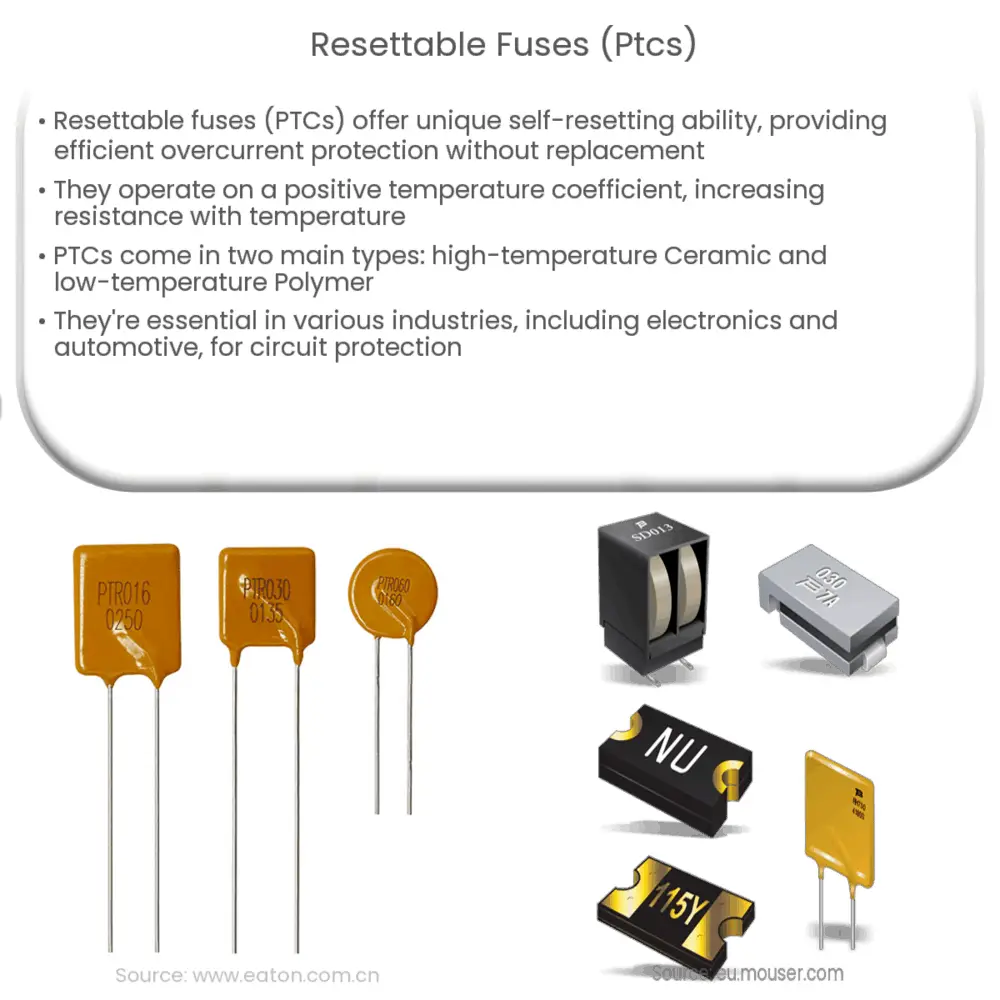Explore the workings, types, applications, advantages, and limitations of Resettable Fuses (PTCs) in various industries.

Introduction to Resettable Fuses (PTCs)
Resettable fuses, also known as Polymeric Positive Temperature Coefficient (PTC) devices, are a type of overcurrent protection devices that have a unique ability to reset themselves after a fault condition has been cleared. Unlike traditional fuses which need to be replaced after a fault, PTCs can continue to function after the issue has been resolved, making them a convenient and efficient choice for various applications.
The Working Principle of PTCs
PTCs work on the principle of positive temperature coefficient, meaning their resistance increases with the rise in temperature. In normal operating conditions, a PTC exhibits low resistance, allowing current to flow freely. However, when an overcurrent condition occurs, the device heats up due to the excessive current. This increase in temperature causes the resistance of the PTC to rise significantly, effectively limiting the current flow and thus protecting the circuit from damage. Once the fault condition is removed and the device cools down, it resets itself, returning to its low-resistance state.
Types of PTCs
- Ceramic PTCs: Ceramic PTCs are made from a doped barium titanate ceramic. They are usually employed in applications that require high power and high hold current. Their operating temperature is generally higher than that of polymer PTCs.
- Polymer PTCs: Polymer PTCs consist of conductive carbon particles embedded in a polymeric base. They are typically used in low-voltage, low-power applications, such as circuit protection in consumer electronics. Polymer PTCs have a lower operating temperature compared to their ceramic counterparts.
Applications of PTCs
PTCs find a wide range of applications owing to their self-resetting ability. They are widely used in electronics to protect against overcurrent and overtemperature conditions. Some of their common applications include:
- Battery Protection: PTCs can protect rechargeable battery packs from overcurrent and short-circuit conditions. They are commonly used in lithium-ion and nickel-metal hydride batteries.
- Telecommunications: In telecommunication devices, PTCs prevent damage due to power surges and overloads, ensuring the stability and reliability of communication networks.
Additional Applications of PTCs
- Computing: PTCs are used in various computer peripherals like modems, printers, and motherboards to guard against overcurrent situations.
- Automotive: In the automotive industry, PTCs help protect sophisticated electronic systems and components from current surges.
- Consumer Electronics: Devices such as mobile phones, game consoles, and digital cameras employ PTCs to protect against excessive current and short-circuits, thus extending their life and reliability.
Advantages and Limitations of PTCs
PTCs offer several advantages, including:
- Resettable Protection: Unlike traditional fuses, PTCs provide resettable protection, eliminating the need for replacement after a fault.
- Versatility: PTCs are available in a variety of sizes and ratings, making them suitable for a wide range of applications.
- Reliability: PTCs are highly reliable, offering consistent performance over their lifetime.
However, they also have certain limitations:
- Slow Reaction Time: PTCs may not react as quickly as traditional fuses, potentially allowing a brief period of excessive current before they trip.
- Temperature Dependence: The performance of a PTC can be affected by the ambient temperature, which can lead to variations in its tripping current.
Conclusion
In conclusion, resettable fuses or PTCs are a crucial component in modern electronics and electrical systems, offering versatile and reliable protection against overcurrent conditions. Their ability to self-reset after a fault eliminates the need for replacement, making them a cost-effective and efficient solution for circuit protection. Despite some limitations, their benefits far outweigh the drawbacks, making them a popular choice in a variety of industries, including telecommunications, automotive, computing, and consumer electronics. As technology continues to evolve, we can expect to see further improvements in PTCs and their applications.

